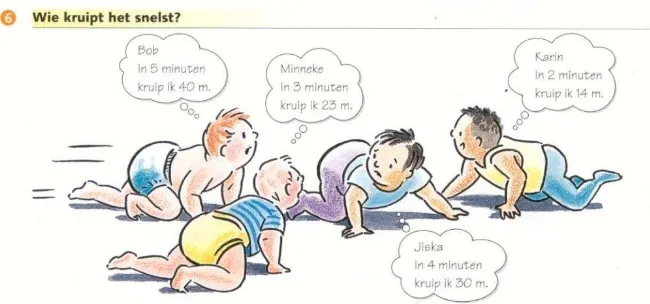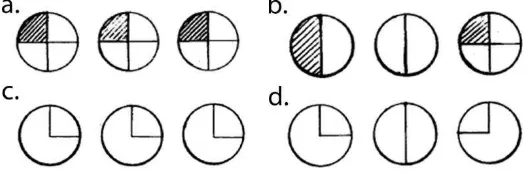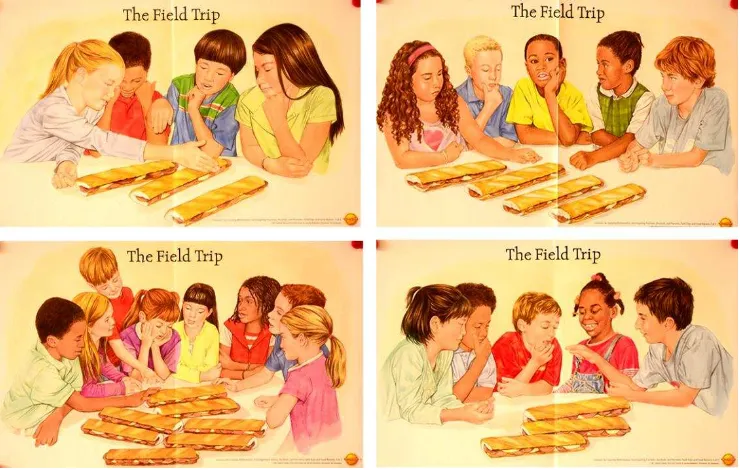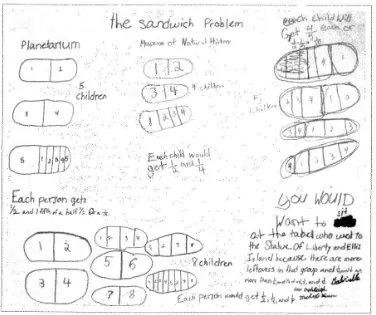12
CONTEXTS AND MODELS IN MATHEMATICS EDUCATION
Frans van Galen
Freudenthal Institute for Science and Mathematics Education (FISME), Utrecht University, The Netherlands
f.vangalen@uu.nl
Abstract
In the plenary panel session of the conference two topics were discussed: the role of contexts in mathematics education and the role of models. This contribution discusses the role of context situations and models within a learning trajectory. The examples are chosen from the learning of fractions. Sharing food is a context that will stimulate students to explore the relations between simple fractions. Asking students to draw thesharing situation can be used to develop the model of the fraction bar. Models play a mediating role between the concrete context problem and formal reasoning.
Keywords : context problems, model, emergent modelling, fractions.
INTRODUCTION
In this introduction to the plenary panel on the SEA-DR conference 2013 I shall address two related topics: the role of contexts in mathematics education and the role of models. We have chosen these topics for the panel discussion because they are central to the theory of Realistic Mathematics Education (RME). With respect to contexts this will be obvious: RME emphasizes that mathematics education should start in solving problems that are experientially real for the students Gravemeijer &Cobb, 2006). Although this does not necessarily mean that all problems should come from daily life - they may also come from mathematics itself - we want to focus here on the way mathematical problems are embedded within situations students know from daily life.
Models - our second topic - play a mediating role between concrete problem situations and abstract mathematics. A model visualizes aspects of the situation and helps one to reason about that situation. Models should not be introduced to students as ready made tools, but they should be constructed by the students themselves. Gravemeijer speaks of emergent models to emphasize that models come into being - emerge - while the student is exploring a certain topic of mathematics.
I will discuss both topics by referring to fractions and the context of sharing food. In their contributions the other members of our panel will discuss more, and different examples.
WHY SHOULD WE USE CONTEXT PROBLEMS?
One of the reasons for presenting mathematical problems within a context is that we want to motivate students to solve these problems. Students should see the problems as interesting questions that are worth their effort. This only works, however, if the mathematical question is really integrated within the context. Let me first give you a negative example.
13 A teacher I have been working with for many years, once started her mathematics lesson by telling about the time her son was 1 year old. He was late in learning to walk, but he could crawl very fast. At this point the teacher had the full attention of her class, and many children came with stories about their baby brother or sister, or their little nephew. Then the teacher handed out a worksheet with the problem of figure 1. A deep sigh went through the class - oh, it is only mathematics - but it was not uncommon that the teacher would use a story from her own life to start a mathematics lesson. This time, however, the teacher had to work very hard to connect the mathematics to the reality of crawling babies. In hindsight, this could have been expected, as there is not much reality in babies who talk about meters and minutes and do so in thinking bubbles. Even more important is that the whole idea of comparing crawling speed is highly problematic. Would baby Bob ever crawl 5 minutes at a stretch?
Figure 1. Who is the fastest crawler? Bob: 40 m in 5 minutes, Minneke: 23 m in 3 minutes, Karin: 14 m in 2 minutes, Jiska: 30 m in 4 minutes.
After a while the teacher succeeded in getting the children to work on the problem and eventually a vivid discussion arose about comparing the different speeds and about who was, indeed, the winning baby. To some extend the lesson was a success, but it was so in spite of the context, not because of the context. An important reason for using context situations is neglected in the baby problem: the context should support students to use their informal knowledge. In this case knowledge about babies and crawling will rather be an obstacle than an aid. That it did not affect the lesson strongly was because the students more or less forgot the context and approached the problem as a pure mathematical problem
What we can learn from this example is that the question whether the context is interesting for students is less important than the question whether the mathematical problem is really embedded within that context. A context should support children s thinking. This applies first and foremost if the goal of the lesson is to build new mathematical knowledge, which will be the focus of this article. Context situations, however, also play a role in mathematics lessons as situations in which students are asked to apply the knowledge and skills they have learned before. Therefore a few words about practice are in order.
APPLYING KNOWLEDGE AND SKILLS
14 as if most of the context problems are intended to let children practice skills they have already mastered. In a minority of the lessons the context problem will help children to develop new mathematical insights. A complication is that the goals of the lessons are not always clear. Most problems are similar to earlier ones and often the teacher guides do not specify what new insights the students should attain when they solve these problems.
Practice in applying knowledge and skills is important. If fractions have been introduced within the context of sharing pizza's, children need to solve problems about pizza's from time to time, in order to refresh their understanding. Even more important are problems where children have to apply their knowledge in contexts that are different from situations they have met before. Treffers (1987, 1991) speaks of 'horizontal mathematising' to characterize situations where students have to transform a problem in order to solve the problem by mathematical means. A problem of sharing pizza s, for example has to be perceived as a problem about fractions, before children can use their knowledge about fractions to solve it. Treffersputs horizontal mathematising in contrast with vertical mathematising , which is described as the process in which children build and expand their knowledge and skills within the world of mathematical symbols.
Design research - the topic of this conference - is by definition research about possible ways to help children develop new mathematical knowledge. In design research the researcher should always be very explicit about what he or she hopes to attain in a lesson. The researcher does so by specifying the goals for the lesson, but, even more importantly, by specifying a hypothetical learning trajectory.
KNOWLEDGE CONSTRUCTION
One of the most productive ways of fostering new mathematical insights is to let children comparetheirown way of reasoning with the way others have reasoned. This puts class discussions in the centreof mathematics education. Quite often, however, teachers limit the conversation to successive presentations of solutions, treating the reasoning of each child or group as isolated facts.
Also many teachers do not realize that the context problems they ask students to solve should only be means to a goal, not the goal itself. The goal of the lesson is not so much that the problem will be solved at the end of the lesson; what matters is that students learn from the discussions about mathematics that can be raised by such a problem.
This puts strong demands on the mathematical problems that we may present in the lessons:
Preferably all students in the class should find a way to deal with the problem. Some proficient children may find an efficient solution at a relatively high level, but the problem should offer all the others enough grip to find at least a beginning of a solution. All children should have the feeling that they can make steps.
15 above establishing that different solutions are possible.
The problem should also raise exactly that discussion that is intended in the hypothetical learning trajectory, and will help to advance the understanding of the students at some specified point.
There are no simple recipes for the construction of good mathematical context problems. A first step is to choose a suitable context. It should be a context that is familiar and meaningful to the students, and will appeal to them. Finding such a context is no guarantee, however, that the problem will raise precisely the discussion the designer had intended. Details are important; sometimes they support the students, sometimes they distract. The numbers that are chosen play a crucial role. If the numbers are too simple, students may immediately see a solution, without consciously structuring the data. If the numbers are less convenient, children may get lost in complicated calculations, and this may push the actual problem to the background.
A context should support children, but this means that contexts that work well within one situation cannot be copied blindly for another situation. What is self-evident for children in one country may not be so for children in another country. What counts is the experience children have within that context.
AN EXAMPLE: FROM PIZZA’S TO PEMPEK
The world of fractions is a complicated world and there are different roads to introduce children into this world (van Galen et al. 2008). One may start from measuring situations where the measuring unit is too large for precise measurements and should be refined. One may also start with the exploration of sharing situations. Such situations play a major role in the research of Leen Streefland (1991). He introduces fractions by asking students how, for example, four children would be able to share three pizza s.
Figure 2. Solutions for the problem of four children sharing three pizza’s
A problem like this evokes different types of solutions:
Each pizza may be cut into four pieces, so every child gets three times a quarter of a pizza (Figure 2a).
The first two pizza s can easily be shared among four children by giving each child half a pizza. The remaining pizza is cut into four pieces (Figure 2b). Three children get a whole pizza, but each has to give a quarter of their pizza to the last child (Figure 2c).
If the students already know that the end result has to be 3/4 pizza for each, they can make portions of 3/4 of a pizza (Figure 2d).
16 described, for example, as:
3 x 1/4 pizza
1/2 pizza + 1/4 pizza 3/4 pizza
1 pizza - 1/4 pizza
)n the Netherlands sharing pizza s offers a good context for the exploration of relations between fractions. The accompanying story - an important part of the context - could be that the pizza s in the restaurant are so big that children will not be able to finish a whole pizza, so father orders only three pizza s for his four children. Another story could be that mother has only frozen pizza s left in the freezer. These are stories that are recognizable for Dutch children, which means that they can bring in all they know about cutting pizza s and about sharing. The context of fair sharing also appeals to their sense of justice, a motivational aspect.
A good problem context for Dutch children is not necessarily a good one for children in another country. When we developed the first version of Mathematics in Context for American middle schools (van Galen et al., 1997), we did not choose for the sharing of pizza s, but for the sharing of subs. A sub - which is short for submarine - is a long piece of bread, typically with both cheese, meat, and salad. )n the Contexts for learning mathematics series, by Cathy Fosnot and others a similar situation is used. Figure 3 shows four of the posters that accompany the booklet Field Trips and Fund-Raisers Fosnot, . The story is that small groups of children of a school in New York go on different field trips: four kids go to the Museum of Natural History, five to the Museum of Modern Art, eight to the Statue of Liberty and five to the planetarium. The groups get different numbers of subs for lunch and this raises the question which group is best off in this respect and which group has least to eat for lunch. Take a bit of time to solve this problem yourself. I shall discuss some approaches below.
Figure 3. The field trip problem from Fosnot (2008)
17 The first one had to do with the cultural context: in the United States it is common that pizza s will be cut beforehand by the kitchen personnel. More important, however, was that we wanted to use the sharing context as a first step towards working with the fraction bar (Figure 4 gives an example), and the drawing of a sub, without the details of the filling etcetera, is almost a bar. I will come back to this later. What would be a good context for a sharing problem in Indonesia? Sharing bread or pizza s is not a good choice, obviously. Preferably it should be something rectangular and something oblong that will be cut in one direction only, because that is also how the fraction bar will be divided into parts. In Palembang, where this conference is held, pempek would be an obvious choice. It is sold in many different forms. For mathematics books that should be used in the whole of Indonesia, maybe a different kind of food should be chosen.
To round off the discussion of this example, what makes sharing a good context for the exploration of fractions?
Sharing situations are familiar and do appeal to children.
Children will use all of their practical knowledge of sharing and cutting to solve such a problem.
They will come with different solutions, and these solutions can be used by the teacher to raise a discussion about fractions.
From drawing a sub or an oblong piece of pempek to drawing a fraction bar is only a small step.
WHO WILL GET MOST? WHO WILL GET LEAST?
The problem of Figure 2, about sharing subs, is too interesting to leave out a
Figure 5, from Fosnot and Dolk (2002), shows how the problem has been solved by Gabrielle, Michael and Ashleigh. Their solution is on a very concrete level, with a drawing of how each sub would be cut and numbers indicating the children. Notice that for three of the situations these students first give everyone half a sub and then they let them share what remains.
How would you solve the problem yourself? One possible way of reasoning is: In each of the situations a, b and c there is one child who cannot get his or her own sub, which means that the other children have to give a part of their sub to that last child. It is clear then that in a group of eight the part a child has to give away will be smaller than in a group of five or four. So situation c will be the most favourable and situation b the least favourable of these three. Situation d is even more unfavourable than situation b, as five in stead of four children have to share three subs. This way of reasoning is more general than that of Gabrielle, Michael and Ashleigh, but it is still in terms of concrete actions within the situation.
18 a. 4/5 = 1 - 1/5
b. 3/4 = 1 - 1/4 c. 7/8 = 1 - 1/8
Because 1/8 is smaller than 1/4 and 1/5, 7/8 is the largest fraction of these three. The smallest fraction of all four is 3/5, because 3/5 is smaller than 3/4 and smaller than 4/5.
Figure 4. One of the solutions for the field trip problem (from Fosnot & Dolk, 2002)
It is good to realise that for students age 8 or a bit older, the problem of figure 2 is a very complicated problem and that they will need a lot of time to figure out an answer. It is in fact a problem that is worth to spend at least three lessons on: one lesson for the introduction of the problem, and a first discussion of possible approaches, one lesson in which the students work in small groups and prepare a poster for a presentation (like figure 4), and one lesson for what Fosnot and Dolk call the math congress , a discussion in which the groups present their solutions and the teacher stimulates a discussion about the more general mathematical issues that lie behind this concrete problem situation. In this respect the sharing problem suggests a kind of mathematics lessons that deviate significantly from what is usual in Indonesia and in the Netherlands, or, for that matter, in the United States.
A LEARNING TRAJECTORY
19 fractions as self-contained mathematical objects. The sharing problem would be one of the early problems in this learning trajectory, so what could be the steps that follow?
An important element in this learning trajectory should be to give students the opportunity to develop a network of number relations (van Galen et al., 2008). For young children fractions like 1/2, 3/4 and 1/3 are strongly connected to situations in their daily life: half of an apple, 3/4 of a chocolate bar, and so on. If a child knows how much is 3/4 of a chocolate bar, that does not mean that the child also knows 5/6 of a chocolate bar. The start of a learning trajectory on fractions should aim at familiarizing children with the relations between simple fractions. So, within the context of chocolate bars, for example, the students could learn:
1/4 bar + 1/4 bar = 1/2 bar
1/6 bar + 1/6 bar + 1/6 bar = 1/2 bar 5/6 bar = 1/2 bar + 1/6 bar + 1/6 bar
As Streefland (1991) suggests, we should stimulate children to add the object name - bar in this case - in these expressions. It ascertains that the expressions remain connected to the concrete situation, and it keeps children from random manipulations with numerators and denominators.
On the solid base of a growing network of relations between fractions, students may learn to see fractions as mathematical objects that can be used as tools for reasoning within many different contexts. Then expressions like the following will become meaningful:
2/4 = 1/2 3 x 1/6 = 1/2 1/2 + 1/3 = 5/6
There is a long road between reasoning with fractions connected to concrete objects and reasoning with fractions on a formal level. This is where models come in, as representations that can play a mediating role in this process. The main model for fractions is the bar model. To prove, for example, that 1/2 + 1/3 = 5/6, a student might draw how a bar can becut into six equal parts, of which three add up to 1/2, and two add up to 1/3 (see Figure 4).
Figure 4. A fraction bar showing that 1/2 + 1/3 = 5/6.
In figure 4 the bar does not necessarily represent a specific concrete object - like a sub, a piece of pempek or a chocolate bar - but it is still a concrete representation of the whole and its parts. Drawing this bar keeps children from making mistakes like 1/2 + 1/3 = 2/5.
20 take much time, and actually much more time than most curricula do allow. Even if fractions are introduced in connection to situations from daily life, textbooks generally ask children to work with bare fractions after a very short time.
We may characterise a desired learning trajectory for fractions, very briefly, in the following steps. The distinction between model of’ and model for’was introduced by Streefland(1991) and Treffers (1991), and has beenelaborated by Gravemeijer (1999).
The start lies in the exploration of problems within contexts that students know from their daily life. The students become familiar with fractions and the relations between fractions.
Students learn to draw representations of concrete situations and use these to solve the problems. These representations are a model of the situation.
Students begin to value a certain representation as a model that can be applied within a variety of contexts. The model becomes a model for fraction contexts. expression suggests that the model is out there already, and that the students simply have to grab and apply the model. Within this language one may easily overlook that a fraction bar may mean something completely different for the teacher and for the student. The teacher may see a drawing like that of figure 4 as a representation of relations between fractions - formal knowledge - but the student may just see it as a somewhat simplified drawing of a real sub or chocolate bar. This is also why we have to be careful with materials like wooden fraction circles, or coloured fraction sticks. The model is not what we see, but what is in the mind of the student. And these ideas of students are not fixed, but develop over time.
Gravemeijer (1999) speaks of 'emergent models', to emphasize this development. The model initially emerges as a model of informal mathematical activity and gradually develops into a model for more formal mathematical reasoning. The drawing of a circle which is divided into parts may initially represent the activity of sharing pizza's, but later it may become a model for reasoning with fractions. In both situations it is the activity that counts, the actual reasoning, not the sketch itself. The same is true for children who in grade 4 draw on paper how they would divide subs or pieces of pempek and in grade 6 draw fraction bars if they are asked a difficult fraction problem.
21
REFERENCES
Fosnot, C.T. & Dolk, M. (2002). Young Mathematicians at Work: Constructing Fractions, Decimals, and Percents. Portsmouth: Heinemann.
Fosnot, C.T. (2008). Field Trips and Fund-Raisers: Introducing Fractions (Contexts for Learning Mathematics, Grades 4-6). Heinemann
Gravemeijer, K. (1999). How emergent models may foster the constitution of formal mathematics. Mathematical Thinking and Learning, 1 (2), 155–177.
Gravemeijer, K.P.E. & Cobb, P.(2006). Design research from a learning design perspective. In: Akker, J., Gravemeijer, K., McKenney, S., Nieveen, N.(Eds).
Educational Design Research. London: Routledge, Taylor Francis Group, pp. 45-85.
Streefland, L. (1991). Fractions in realistic mathematics education: A paradigm of developmental research. Dordrecht, the Netherlands: Kluwer.
Treffers, A. (1991). Didactical background of a mathematics program for primary education. In L. Streefland (ed.) Realistic mathematics education in primary school, 21-56.
Treffers, A. (1987). Three dimensions: A model of goal and theory description in mathematics instruction-The Wiskobas Project. Dordrecht: Reidel.
van Galen, Wijers, Burrill & Spence (1997) Mathematics in Context: Some of the Parts. Encyclopaedia Brittanica Educational Corporation.
van Galen, F., Feijs, E., Figueiredo, N., Gravemeijer, K., Herpen, E., & Keijzer, R. (2008).
Fractions, Percentages, Decimals, and Proportions: A Learning-Teaching Trajectory for Grade 4, 5 and 6. Rott
This paper can be cited as Zulkardi(2013). Proceeding The First South East Asia Design/Development Research (SEA-DR) International



